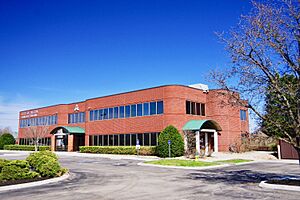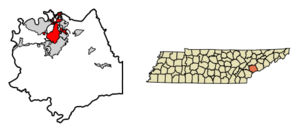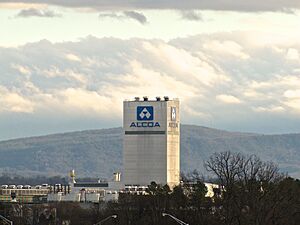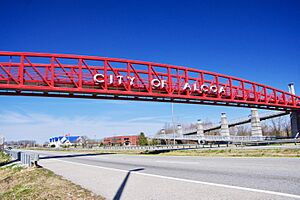Alcoa, Tennessee facts for kids
Quick facts for kids
Alcoa, Tennessee
|
|||
|---|---|---|---|

Alcoa Municipal Building
|
|||
|
|||

Location of Alcoa in Blount County, Tennessee.
|
|||
| Country | United States | ||
| State | Tennessee | ||
| County | Blount | ||
| Incorporated | 1919 | ||
| Named for | Aluminum Company of America | ||
| Area | |||
| • Total | 15.92 sq mi (41.22 km2) | ||
| • Land | 15.00 sq mi (38.85 km2) | ||
| • Water | 0.92 sq mi (2.37 km2) | ||
| Elevation | 932 ft (284 m) | ||
| Population
(2020)
|
|||
| • Total | 10,978 | ||
| • Density | 731.82/sq mi (282.56/km2) | ||
| Time zone | UTC-5 (Eastern (EST)) | ||
| • Summer (DST) | UTC-4 (EDT) | ||
| Area code(s) | 865 | ||
| FIPS code | 47-00540 | ||
| GNIS feature ID | 2403075 | ||
Alcoa is a city located in Blount County, Tennessee, United States. In 2020, about 10,978 people lived there. It is part of the larger Knoxville, TN Metropolitan Statistical Area.
The city's name, Alcoa, comes from the Alcoa corporation. This company, originally called the Aluminum Company of America, had a very large aluminum smelting plant here. A smelting plant is where metal is taken out of its ore. The town was first known as North Maryville. It officially became "Alcoa" in 1919.
Contents
History of Alcoa
How Alcoa Started
Around 1907, the Aluminum Company of America (ALCOA) started looking for a place to build a big aluminum factory. They needed a lot of electricity for smelting aluminum. The Little Tennessee River, about 20 miles (32 km) away, had great potential for hydroelectric power. This means using water to make electricity.
In 1910, the company set up a first camp. They later chose North Maryville for their main factory. The mayor of Maryville, Samuel Everett, helped them decide. By 1914, ALCOA bought 700 acres (2.8 km²) of land. They started building the factory and 150 homes for their workers.
The company planned the town carefully for its workers. The design included four main areas: Vose, Springbrook, Bassel, and Hall. Hall was a separate community for the plant's African-American workers. This was a common practice in the past.
Growth During World Wars
World War I made aluminum very important. ALCOA quickly grew its operations in North Maryville. In 1919, a new rolling mill was finished. This mill made aluminum sheets. That same year, the company's town officially became the city of "Alcoa."
C.L. Babcock was Alcoa's first mayor. Victor Hultquist was the first city manager. He also worked for ALCOA. He helped develop the town until 1948. By 1920, Alcoa had 3,358 people living in 700 homes.
During the Great Depression in the United States, ALCOA tried to keep its workers employed. They cut work hours instead of jobs. This helped people stay in Alcoa.
World War II brought a huge demand for aluminum. It was needed to build airplanes. ALCOA's production grew by 600% during the war. The number of workers in Alcoa reached 12,000. In the early 1940s, ALCOA built its North Plant. It was the largest plant under one roof in the world at that time.
Alcoa Today
After World War II, Alcoa became less dependent on the ALCOA company. The company started giving land for schools, parks, and the airport. They also ended the separation of facilities. In the early 1950s, ALCOA began selling company homes to its employees.
In 1956, Ross Walker became the first city manager who did not work for ALCOA. By the end of the 1950s, the company no longer owned the city's utilities. The growth of McGhee Tyson Airport also helped Alcoa's economy. The city now has a more diverse economy.
Geography and Climate
Alcoa is located in the foothills of the Great Smoky Mountains. You can see parts of the mountains from Alcoa Highway. The Little River flows through the eastern part of Alcoa. It then joins the Tennessee River near Louisville.
The city covers about 15.92 square miles (41.22 km²). Most of this is land, and a small part is water.
Weather in Alcoa
Alcoa has a Humid subtropical climate. This means it has warm temperatures and rain throughout the year.
| Climate data for Alcoa | |||||||||||||
|---|---|---|---|---|---|---|---|---|---|---|---|---|---|
| Month | Jan | Feb | Mar | Apr | May | Jun | Jul | Aug | Sep | Oct | Nov | Dec | Year |
| Mean daily maximum °F (°C) | 46 (8) |
51 (11) |
59 (15) |
69 (21) |
77 (25) |
84 (29) |
87 (31) |
86 (30) |
80 (27) |
69 (21) |
59 (15) |
50 (10) |
68 (20) |
| Mean daily minimum °F (°C) | 30 (−1) |
32 (0) |
37 (3) |
46 (8) |
55 (13) |
62 (17) |
68 (20) |
66 (19) |
59 (15) |
46 (8) |
37 (3) |
32 (0) |
48 (9) |
| Average precipitation inches (mm) | 4.6 (120) |
4.4 (110) |
5.2 (130) |
3.8 (97) |
3.9 (99) |
4 (100) |
4.6 (120) |
3.1 (79) |
2.9 (74) |
2.7 (69) |
3.8 (97) |
4.6 (120) |
47.5 (1,210) |
| Source: Weatherbase | |||||||||||||
Population of Alcoa
| Historical population | |||
|---|---|---|---|
| Census | Pop. | %± | |
| 1920 | 3,358 | — | |
| 1930 | 5,255 | 56.5% | |
| 1940 | 5,131 | −2.4% | |
| 1950 | 6,355 | 23.9% | |
| 1960 | 6,395 | 0.6% | |
| 1970 | 7,739 | 21.0% | |
| 1980 | 6,870 | −11.2% | |
| 1990 | 6,400 | −6.8% | |
| 2000 | 7,734 | 20.8% | |
| 2010 | 8,449 | 9.2% | |
| 2020 | 10,978 | 29.9% | |
| 2023 (est.) | 13,349 | 58.0% | |
| Sources: | |||
People in Alcoa (2020 Census)
| Race | Number | Percentage |
|---|---|---|
| White (not Hispanic) | 8,146 | 74.2% |
| Black or African American (not Hispanic) | 1,262 | 11.5% |
| Native American | 32 | 0.29% |
| Asian | 113 | 1.03% |
| Pacific Islander | 3 | 0.03% |
| Other/Mixed | 617 | 5.62% |
| Hispanic or Latino | 805 | 7.33% |
In 2020, there were 10,978 people living in Alcoa. They lived in 3,835 households, with 2,574 being families.
Parks and Recreation
Alcoa's first planners thought parks were very important. They wanted to have one acre of park land for every 100 people. The ALCOA company donated land for parks over the years. In 1998, a 3-mile (4.8 km) section of the Maryville Alcoa Greenway was finished. This path connects Alcoa's Springbrook Park with Maryville's Bicentennial Greenbelt Park.
Education
Most of Alcoa is served by the Alcoa City School District. A few small parts are in the Blount County Schools district.
Transportation
Alcoa is home to McGhee Tyson Airport. This airport is located in Blount County. It is managed by the Metropolitan Knoxville Airport Authority.
Main Roads
- U.S. Route 129: This road is known as "Alcoa Highway" or "Airport Highway." It connects Alcoa to Knoxville in the north. It also goes through Blount County to the North Carolina border.
- Interstate 140/Tennessee State Route 162: Called Pellissippi Parkway, this road links Alcoa to west Knoxville and Oak Ridge.
- State Route 35: This road follows Hall Road.
- State Route 334: Known as Louisville Road, it connects Alcoa to Louisville, Tennessee.
- State Route 335: This road follows Hunt Road and Old Glory Road. It connects Alcoa to eastern and western Blount County.
Many streets in Alcoa are named after famous scientists and inventors. Examples include Bessemer, Joule, Edison, Darwin, and Watt. Other streets are named after ALCOA company officials and engineers.
Notable People
- Randall Cobb: A football player for the Green Bay Packers. He graduated from Alcoa High School in 2008.
- Dave Davis: A former football player in the National Football League.
- Linda Goss: An award-winning storyteller.
- Bessie Harvey: A sculptor who taught herself.
- William Michaels: A boxer.
- Shannon Mitchell: An NFL player.
- Lynn Swann: An NFL player. He was born in Alcoa but grew up in California.
- Sidney A. Wallace: A U.S. Coast Guard Rear Admiral. He received the Meritorious Service Medal.
- Billy Williams: An NFL player for the Washington Redskins.
See also
 In Spanish: Alcoa (Tennessee) para niños
In Spanish: Alcoa (Tennessee) para niños






